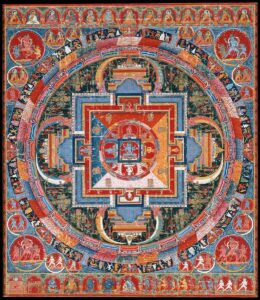Mandala art is more than just intricate designs and patterns; it’s a journey into mindfulness, creativity, and spiritual expression. Derived from the Sanskrit word for “circle,” mandalas represent the universe, unity, and harmony in cultures worldwide. Whether you’re an aspiring artist, a mindfulness enthusiast, or simply curious about this ancient art form, this guide will walk you through everything you need to know about mandala art. From its origins and symbolism to practical tips for creating your own mandalas, we’ve got you covered.
What Is Mandala Art?
At its core, a mandala is a geometric design that often starts from a central point and radiates outward in symmetrical patterns. These intricate artworks are not just visually captivating; they hold deep spiritual and philosophical significance.
Origins and Cultural Significance
- Hinduism and Buddhism:
- Mandalas are prominent in Hindu and Buddhist traditions, often used as tools for meditation and prayer.
- Tibetan sand mandalas are a famous example, painstakingly crafted and then destroyed to symbolize the impermanence of life.
- Native American and Aboriginal Cultures:
- Indigenous peoples have used circular designs to represent life cycles, nature, and spirituality.
- Modern Applications:
- In contemporary contexts, mandalas are used in art therapy, mindfulness practices, and home decor.
Also Read:
Rangoli Art Services
Art Classes for Kids
Art Classes for Adults
Corporate Art Workshop
Art Party for Kids Birthday
Art Party for Adult Celebrations
Symbolism in Mandala Art
Each element of a mandala holds meaning. For example:
- Circle: Unity, wholeness, eternity.
- Square: Stability and grounding.
- Lotus Flower: Spiritual awakening.
- Colors: Different hues symbolize emotions, energies, and elements. For instance:
- Blue: Calmness and tranquility.
- Red: Passion and energy.
- Gold: Enlightenment and wisdom.
Types of Mandala Art
- Traditional Mandalas:
- Rooted in religious practices.
- Often feature specific symbols like deities, flowers, and geometric shapes.
- Healing Mandalas:
- Used for meditation and stress relief.
- Incorporate soothing colors and symmetrical designs.
- Modern Mandalas:
- Artistic interpretations blending traditional motifs with contemporary styles.
- Popular in tattoos, digital art, and graphic design.
How to Create Your Own Mandala
Creating a mandala can be a therapeutic and rewarding experience. Here’s how you can start:
Materials You’ll Need
- Paper or canvas.
- Compass and ruler for precision.
- Pencils, erasers, and fine-tip pens.
- Coloring tools like markers, colored pencils, or paints.
Step-by-Step Guide
- Find Inspiration:
- Look at traditional designs or nature for ideas.
- Decide on a theme or emotion you want to convey.
- Draw the Base:
- Start by drawing a central point and use a compass to create concentric circles.
- Add guiding lines for symmetry.
- Design Patterns:
- Begin at the center and work outward, using shapes like petals, triangles, or abstract patterns.
- Maintain balance and symmetry.
- Add Details:
- Use fine-tip pens to enhance details and create depth.
- Experiment with textures and shading.
- Color Your Mandala:
- Choose a color palette that resonates with your theme.
- Blend and layer colors for a vibrant effect.
- Finalize and Frame:
- Erase guiding lines and make touch-ups.
- Frame your mandala for display or keep it in a sketchbook.
Practical Tips for Beginners
- Start simple: Begin with basic shapes and patterns.
- Use templates: Pre-drawn guides can help you focus on coloring and details.
- Practice mindfulness: Let the process be meditative and stress-free.
Examples of Mandala Art in Daily Life
- Decorative Use:
- Mandalas are often seen in home decor items like tapestries, rugs, and wall art.
- Fashion:
- Intricate mandala patterns are popular in clothing and accessories.
- Mindfulness Tools:
- Coloring books featuring mandalas are widely used for stress relief.
Mandala Art Classes by Rajni Dutta Art
If you’re eager to dive deeper into the world of mandala art, consider joining mandala art classes offered by Rajni Dutta Art. Known for her expertise in folk art fusion, Rajni Dutta provides:
- Comprehensive Workshops: Learn the fundamentals of mandala creation, including symmetry, patterns, and color theory.
- Customized Guidance: Suitable for all skill levels, from beginners to advanced artists.
- Creative Techniques: Explore unique ways to blend traditional mandala designs with modern art styles.
- Relaxing Environment: These classes are designed to be both educational and therapeutic, helping you unwind while expressing your creativity.
Whether you want to enhance your artistic skills or find a new way to relax, these classes offer an enriching experience. Visit Rajni Dutta Art’s official website or contact directly for upcoming schedules and registration details.
Conclusion
Mandala art is a captivating blend of creativity, tradition, and mindfulness. Whether you’re appreciating its beauty, exploring its spiritual roots, or creating your own designs, mandalas offer something for everyone. Start your journey today and discover the transformative power of this timeless art form.

